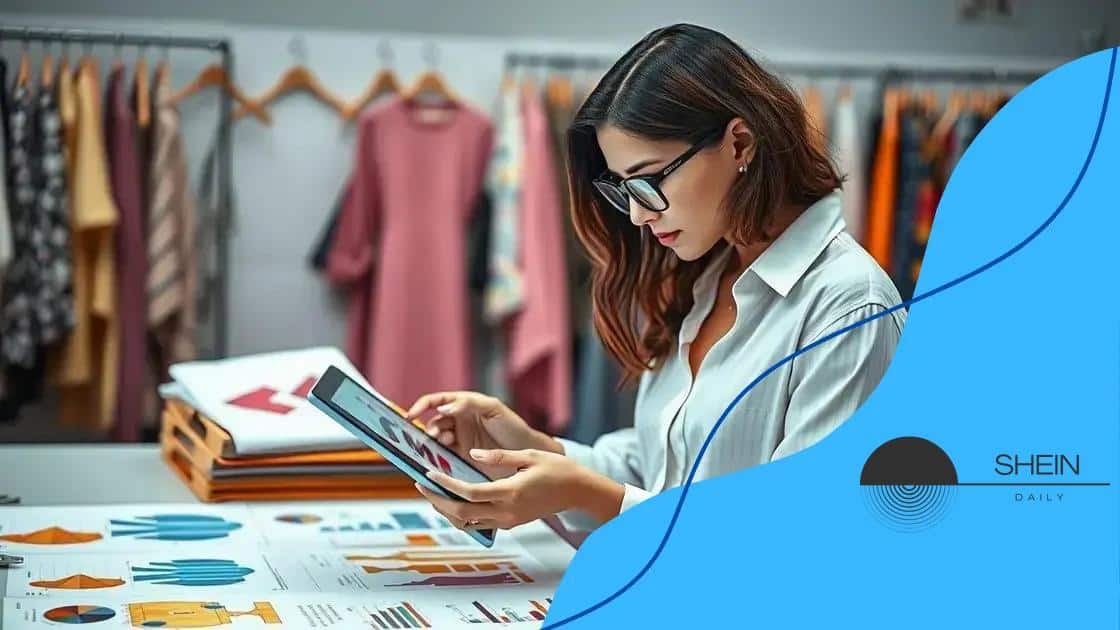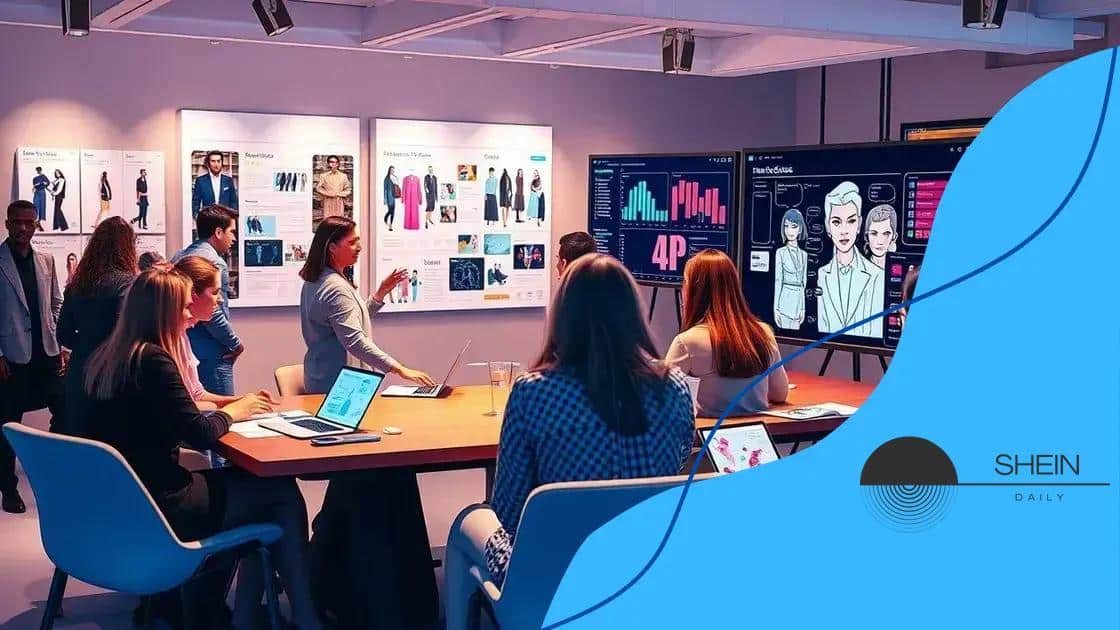Shein’s fashion trend forecasting workshops: a deep dive

Shein’s fashion trend forecasting workshops equip participants with strategies to predict styles and consumer behavior, enabling brands to tailor products effectively and enhance market responsiveness.
Shein’s fashion trend forecasting workshops have turned heads in the industry, sparking curiosity among professionals and consumers alike. But what exactly can one expect from these workshops? Let’s explore.
Understanding trend forecasting in fashion
Understanding trend forecasting in fashion is essential for brands and designers wanting to stay relevant in an ever-changing market. This process anticipates future styles, colors, and patterns, helping businesses plan their collections accordingly.
Trend forecasting relies on various sources of inspiration. Trends can come from social media, street style, art, and even cultural shifts. By analyzing these influences, forecasters provide insights that guide brands in their decision-making processes.
Key Elements of Trend Forecasting
Here are some core components that make up trend forecasting:
- Data Analysis: Collecting and interpreting data about consumer behavior.
- Visual References: Using images and mood boards to convey ideas.
- Market Research: Studying competitors and market dynamics.
- Collaboration: Working with other designers to share insights.
Fashion is not just about clothes; it is a reflection of society. Trends emerge as a response to cultural movements, making the context of forecasting even more crucial. For example, the rise in sustainable fashion is a direct response to consumer demands for environmentally friendly practices. This adaptation to change illustrates the power of succinct trend forecasting.
Moreover, technology plays a pivotal role in how trends are predicted today. Advanced analytics and AI tools help forecasters process vast amounts of data, leading to more accurate predictions. These innovations not only enhance accuracy but also speed up the forecasting process, empowering brands to make timely decisions.
Staying attuned to the nuances of fashion trends allows brands to innovate continuously. The cycle of constantly reviewing past trends to inform future styles can prevent fashion businesses from falling behind and promote a proactive approach in the market.
The role of Shein in modern fashion
Shein has become a significant player in the world of fashion, shaping how trends are created and consumed. Its impact on modern fashion is not just about styles; it’s about the entire shopping experience.
The brand’s model of fast fashion allows it to quickly deliver the latest trends to its customers. This speed is largely due to its effective use of data analytics. By analyzing consumer behavior and preferences in real time, Shein adjusts its inventory to meet the demands of shoppers.
Innovation in Fashion Retail
Shein’s approach to retail embodies several innovative strategies:
- Micro-collection Drops: Frequent releases of small batches of new styles to keep customers engaged.
- User-Generated Content: Encouraging customers to share their outfits, creating a community around the brand.
- AI Utilization: Leveraging artificial intelligence to predict trends based on customer data.
- Sustainable Practices: Beginning to incorporate eco-friendly materials in response to consumer demand for sustainability.
The accessibility of Shein is another critical aspect of its success. The brand offers a wide range of sizes and styles at affordable prices, making fashion more inclusive. This strategy not only caters to a broader audience but also encourages more customers to experiment with their wardrobe.
Furthermore, Shein enhances its presence through social media, connecting with younger audiences in a way many traditional brands have struggled to do. By actively engaging with trends on platforms like TikTok and Instagram, Shein has cultivated a loyal following.
Ultimately, Shein’s role in modern fashion reflects how the industry is evolving. Its blend of fast fashion, tech-driven insights, and community engagement is reshaping how consumers approach their wardrobe. As Shein continues to grow, its influence on fashion trends will likely become even more profound.
Key strategies from Shein’s workshops

Key strategies from Shein’s workshops provide valuable insights for fashion professionals looking to thrive in a competitive landscape. These workshops emphasize the importance of understanding consumer behavior and adapting quickly to new trends.
One major focus is the role of data analytics. Shein teaches participants how to gather and analyze data to make informed decisions. Understanding what customers want helps brands create products that resonate with their audience.
Collaborative Learning
Shein promotes a collaborative approach in its workshops, encouraging participants to share their insights and experiences. This interaction fosters a sense of community among fashion professionals. Some essential strategies discussed include:
- Networking: Building connections that can lead to partnerships and opportunities.
- Feedback Loops: Collecting customer feedback to tailor products better.
- Trend Adaptation: Quickly shifting strategies based on emerging trends.
Another critical element is the emphasis on sustainability. Shein is beginning to incorporate eco-conscious practices into its operations, and the workshops guide attendees on how to innovate within this space. Strategies around sustainable sourcing and production methods are crucial in today’s fashion landscape.
Moreover, the workshops stress the importance of social media in marketing. Participants learn how to create engaging content that resonates with followers. By understanding platforms like Instagram and TikTok, brands can effectively reach their target audience.
These workshops are more than just instructional sessions; they are transformative experiences for fashion professionals. By applying the strategies learned at Shein’s workshops, brands can enhance their innovation and maintain a competitive edge in the fast-changing world of fashion.
Real-world applications of trend forecasting
Real-world applications of trend forecasting highlight how fashion brands can stay ahead in a dynamic market. By effectively predicting trends, companies can tailor their collections to meet consumer demands.
One significant application is in product development. Brands can create items that resonate with customers by focusing on upcoming styles and preferences. This tactic reduces the risk of overproduction and minimizes waste.
Inventory Management
Another crucial area is inventory management. Accurate forecasting allows brands to maintain optimal stock levels. This is essential for:
- Reducing excess inventory: Preventing overstock situations that can lead to markdowns.
- Improving cash flow: Allocating resources effectively based on anticipated sales.
- Enhancing customer satisfaction: Ensuring popular items are always available.
Trend forecasting also plays a vital role in marketing strategies. Brands can launch targeted campaigns that align with the trends consumers are interested in. By using social media analytics and market research, companies can craft messages that resonate with their audience.
Furthermore, collaboration between departments strengthens the application of trend forecasting. Designers, marketers, and sales teams can work together to create cohesive strategies aligned with identified trends. This collaboration may involve brainstorming sessions to discuss insights gathered from trend reports.
Another example of trend forecasting in action is its role in sustainability. Brands are increasingly seeking to predict consumer demand for eco-friendly products, allowing them to adjust their offerings accordingly. By focusing on sustainable practices and materials, companies can meet the growing interest in ethical fashion.
Impact on consumer behavior and choices
The impact of trend forecasting on consumer behavior and choices is significant in the fashion industry. As brands become more adept at predicting trends, they shape how consumers perceive style and make purchase decisions.
Today’s consumers are increasingly influenced by social media. Trend forecasting helps brands align their offerings with the latest styles showcased by influencers. This connection means that when a style or product goes viral, brands are ready to deliver similar items quickly, meeting the immediate demand.
Shaping Purchase Decisions
Understanding what drives consumer choices is crucial. Here are several factors that trend forecasting affects:
- Timeliness: Brands that respond rapidly to trends can attract more customers.
- Personalization: Tailoring offerings based on consumer insights can lead to better engagement.
- Brand Loyalty: Consistency in aligning with consumer desires builds trust and loyalty over time.
As consumers become more aware of trends, their expectations evolve. They now anticipate frequent updates to product lines and a greater variety of options. Trend forecasting enables brands to meet these expectations, ensuring that they always have the styles customers want.
Moreover, the impact on consumer behavior also extends to purchasing habits. With the rise of fast fashion, consumers often buy items based on trends rather than needs. This shift has allowed brands to create a cycle where consumers continuously seek out the newest styles, driving sales.
In summary, the relationship between trend forecasting and consumer behavior is dynamic and multifaceted. As brands become more in tune with what consumers desire, they can influence preferences and drive choices in a way that benefits both parties.
FAQ – Frequently Asked Questions about Trend Forecasting in Fashion
What is trend forecasting?
Trend forecasting is the process of predicting future fashion styles, colors, and patterns based on cultural and consumer insights.
How does trend forecasting impact consumer behavior?
It shapes consumer preferences by aligning brand offerings with the latest trends, influencing purchase decisions.
Why is data analytics important in trend forecasting?
Data analytics helps brands understand consumer behavior and preferences, leading to more accurate predictions and strategies.
How can brands respond quickly to trends?
Brands can utilize trend forecasting to streamline product development and inventory management, ensuring they meet consumer demand promptly.





